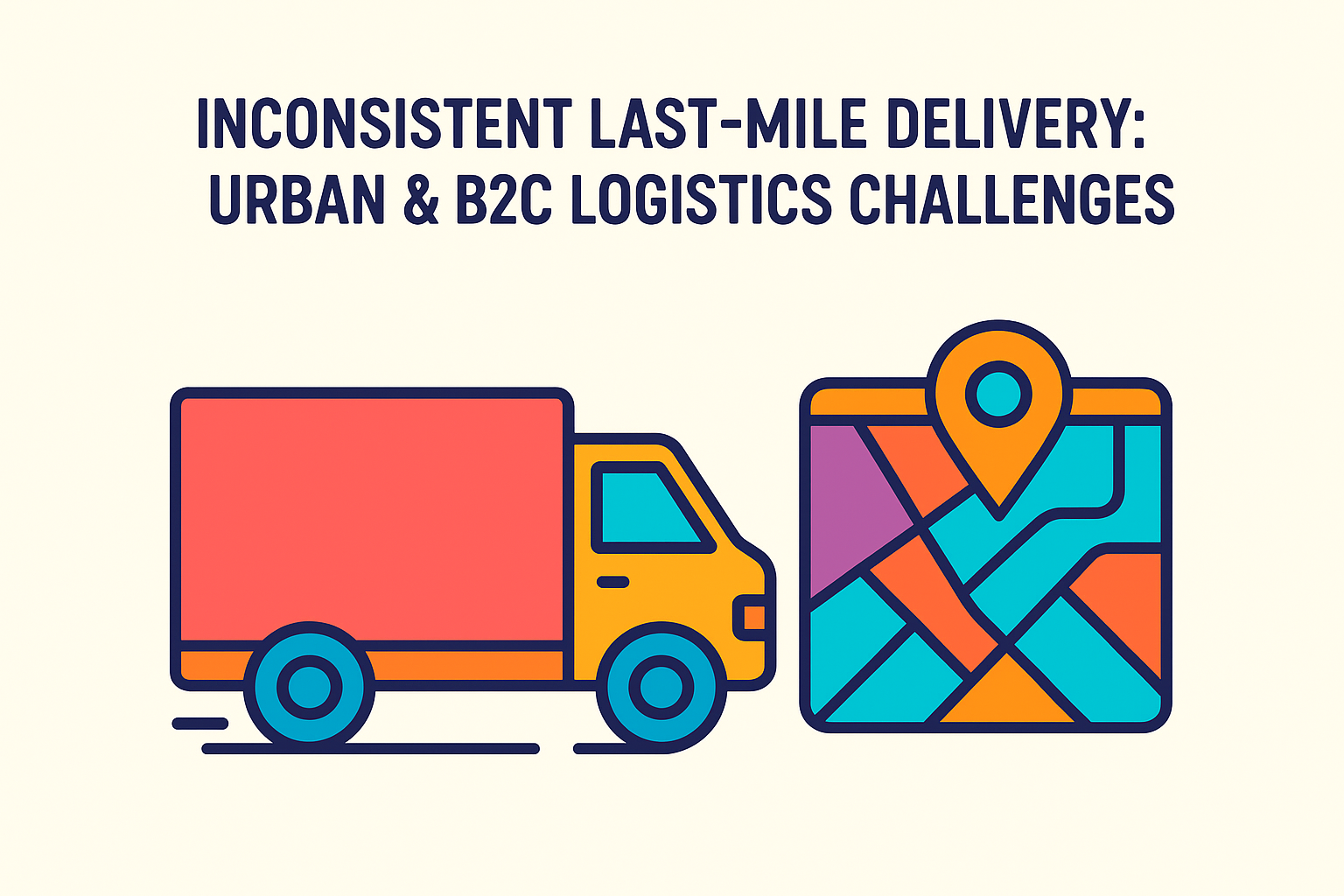Why Inconsistent Last-Mile Delivery Is Holding Your Logistics Back
In urban areas and international B2C logistics, last-mile delivery has become a growing challenge. With rising consumer expectations for fast and transparent deliveries, logistics teams face the pressure to meet demands that their infrastructure is often ill-equipped to handle. In cities, congestion, narrow streets, and unpredictable weather all contribute to delayed deliveries. Meanwhile, in international logistics, customs delays and fluctuating demand further complicate timely service.
In this article, we’ll explore the root causes of inconsistent last-mile delivery, offer practical solutions to overcome these challenges, and show how technology and smarter logistics planning can help you maintain customer satisfaction while keeping costs under control.
The Growing Challenge of Last-Mile Delivery in Urban Logistics
Urban areas present some of the most significant challenges for last-mile delivery. Congestion is a major factor, with trucks often stuck in traffic for longer than necessary. Parking is another obstacle, with limited spaces available in densely populated regions, forcing delivery drivers to waste time finding parking spots.
The stakes are high for businesses operating in these areas. A delayed delivery leads to unhappy customers and may result in lost future business. With next-day and same-day delivery options becoming the new norm, urban logistics must adapt to stay competitive.
How to Improve Last-Mile Delivery in B2C Logistics
Improving last-mile delivery in both urban and international B2C logistics requires a multi-faceted approach. Here are the top strategies for tackling the issue:
1. Leverage Predictive Analytics for Smarter Routing
Predictive analytics enables logistics teams to optimize routes based on historical traffic data, weather conditions, and real-time visibility. By using smart routing algorithms, you can reduce delays and improve delivery times. A U.S.-based manufacturer recently reduced total freight costs by 13% and improved on-time, in-full (OTIF) delivery by 4% using predictive analytics for route optimization.
By incorporating predictive analytics into your TMS system, you can make proactive decisions rather than reacting to delays as they happen. This allows you to avoid potential bottlenecks and ensure timely deliveries.
2. Utilize Micro-Hubs for Urban Areas
Micro-hubs are small, strategically placed warehouses near high-density delivery areas. By using micro-hubs, you can reduce the time it takes to get deliveries to customers, especially in congested urban regions. Instead of one large distribution center serving an entire city, multiple micro-hubs provide a faster, more agile response to customer demand.
For example, Amazon and UPS have successfully used micro-hubs in cities to streamline last-mile deliveries. These hubs help avoid congestion and enable smaller delivery vehicles like electric bikes or cargo vans to navigate narrow city streets efficiently.
3. Embrace Cross-Border Shipping Transparency with Real-Time Visibility
In international logistics, last-mile delivery challenges often arise due to customs delays, documentation errors, and unexpected border issues. One way to tackle this is by implementing real-time visibility tools that offer end-to-end tracking.
With a TMS cloud solution that provides real-time updates, you can keep customers informed of their shipment’s progress, helping to manage expectations and reduce uncertainty. Transparency improves customer satisfaction and enables logistics teams to handle exceptions before they escalate.

4. Collaborate with Local Carriers for Flexibility
When it comes to urban last-mile delivery, collaborating with local carriers can significantly improve service efficiency. Local carriers understand their neighborhoods better and have access to smaller delivery vehicles better suited for dense, congested streets.
By partnering with local delivery providers, you can ensure more reliable deliveries, better response times, and more flexible routing. This local knowledge also helps avoid delays caused by unforeseen street closures or traffic incidents.
5. Invest in Real-Time Communication and Customer Alerts
Effective communication can make all the difference in last-mile logistics. By using real-time communication channels like SMS, email, or in-app notifications, logistics teams can keep customers informed about delivery times and potential delays. Proactive communication ensures customers know when to expect their shipments and reduces frustration when delays are unavoidable.
Best Practices for Optimizing Last-Mile Delivery Efficiency
Here are some actionable steps to improve last-mile delivery efficiency:
- Audit your routes regularly: Identify patterns of underutilization or inefficiency in routes and adjust accordingly.
- Integrate traffic and weather data: Leverage real-time data feeds into your TMS to predict delays and reroute shipments proactively.
- Invest in predictive forecasting tools: Use historical data to predict demand fluctuations and adjust your fleet accordingly.
- Collaborate with regional carriers: Use local knowledge to improve delivery times and service reliability.
- Improve tracking and visibility: Give customers real-time updates and reduce frustration caused by delays.
The Role of Technology in Solving Last-Mile Delivery Challenges
Technology is playing a pivotal role in reshaping the future of last-mile delivery. From predictive routing to real-time tracking and data analytics, logistics companies are leveraging these tools to improve delivery times, enhance customer experience, and reduce operational costs.
A smart TMS that integrates these technologies is essential for improving last-mile performance. TMS cloud solutions are designed to provide end-to-end visibility, automate manual processes, and help logistics teams make better decisions in real-time. By adopting these technologies, logistics providers can stay ahead of the curve, improving service quality and maintaining customer satisfaction.
Overcoming Last-Mile Delivery Challenges
Inconsistent last-mile delivery is a major obstacle for logistics teams, particularly in urban and international B2C logistics. However, with the right strategies, such as predictive analytics, micro-hubs, real-time communication, and collaborations with local carriers, you can overcome these challenges and improve delivery performance.
By implementing smarter logistics solutions and embracing technology, logistics companies can meet the growing demand for fast, reliable, and transparent last-mile delivery. The future of last-mile delivery is here, and those who adapt quickly will lead the way.
Ready to improve your last-mile delivery performance? Book your free demo with FTM today and see how we can help optimize your routes, improve delivery speed, and enhance customer satisfaction.
